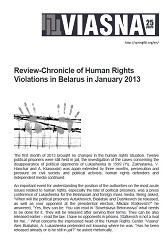
Review-Chronicle of Human Rights Violations in Belarus in January 2013
Review-Chronicle of Human Rights Violations in Belarus in January 2013
Compilation of the monthly 2013 Human-Rights-Reports as published by VIASNA Human Rights Center
More...
Compilation of the monthly 2013 Human-Rights-Reports as published by VIASNA Human Rights Center
More...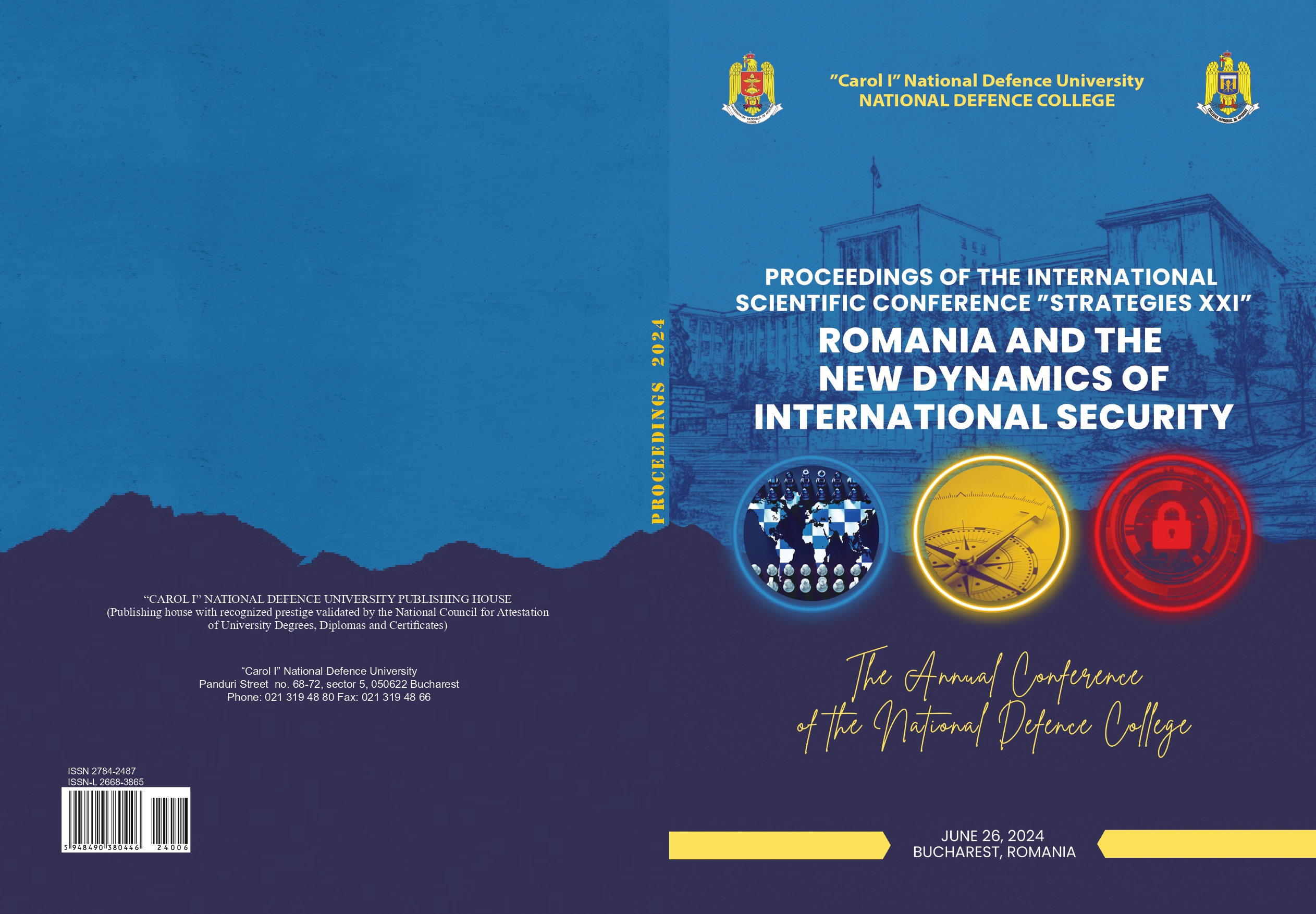
Keywords: state; quasi-states; challenge; threat; security.
The article deals with the issues of unrecognized states that function in the international environment. These are states that have declared independence but have not been recognized by other states. The article refers to terminological issues related to unrecognized states and the features that characterize them. The main aim of the article is to present states that are not recognized as a challenge to international security. This has been done on several examples. Moreover, scenarios for the development of the future of unrecognized states are analyzed.
More...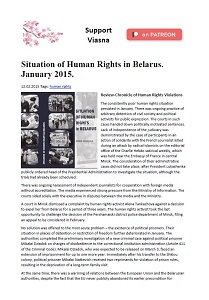
Compilation of the monthly 2015 Human-Rights-Reports as published by VIASNA Human Rights Center
More...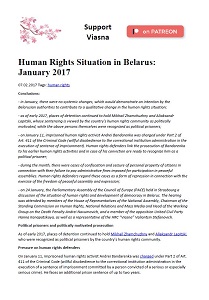
Compilation of the monthly 2017 Human-Rights-Reports as published by VIASNA Human Rights Center
More...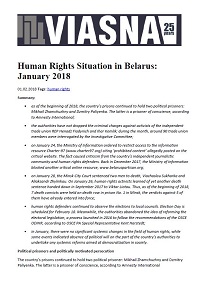
Compilation of the monthly 2018 Human-Rights-Reports as published by VIASNA Human Rights Center
More...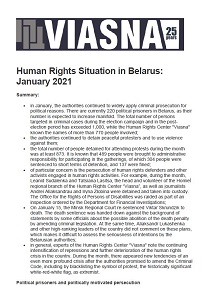
Compilation of the monthly 2021 Human-Rights-Reports as published by VIASNA Human Rights Center
More...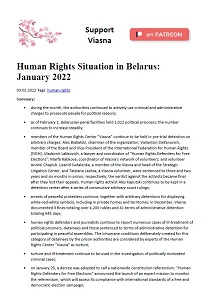
Compilation of the monthly 2022 Human-Rights-Reports as published by VIASNA Human Rights Center
More...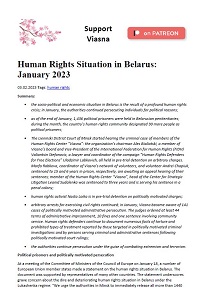
Compilation of the monthly 2023 Human-Rights-Reports as published by VIASNA Human Rights Center
More...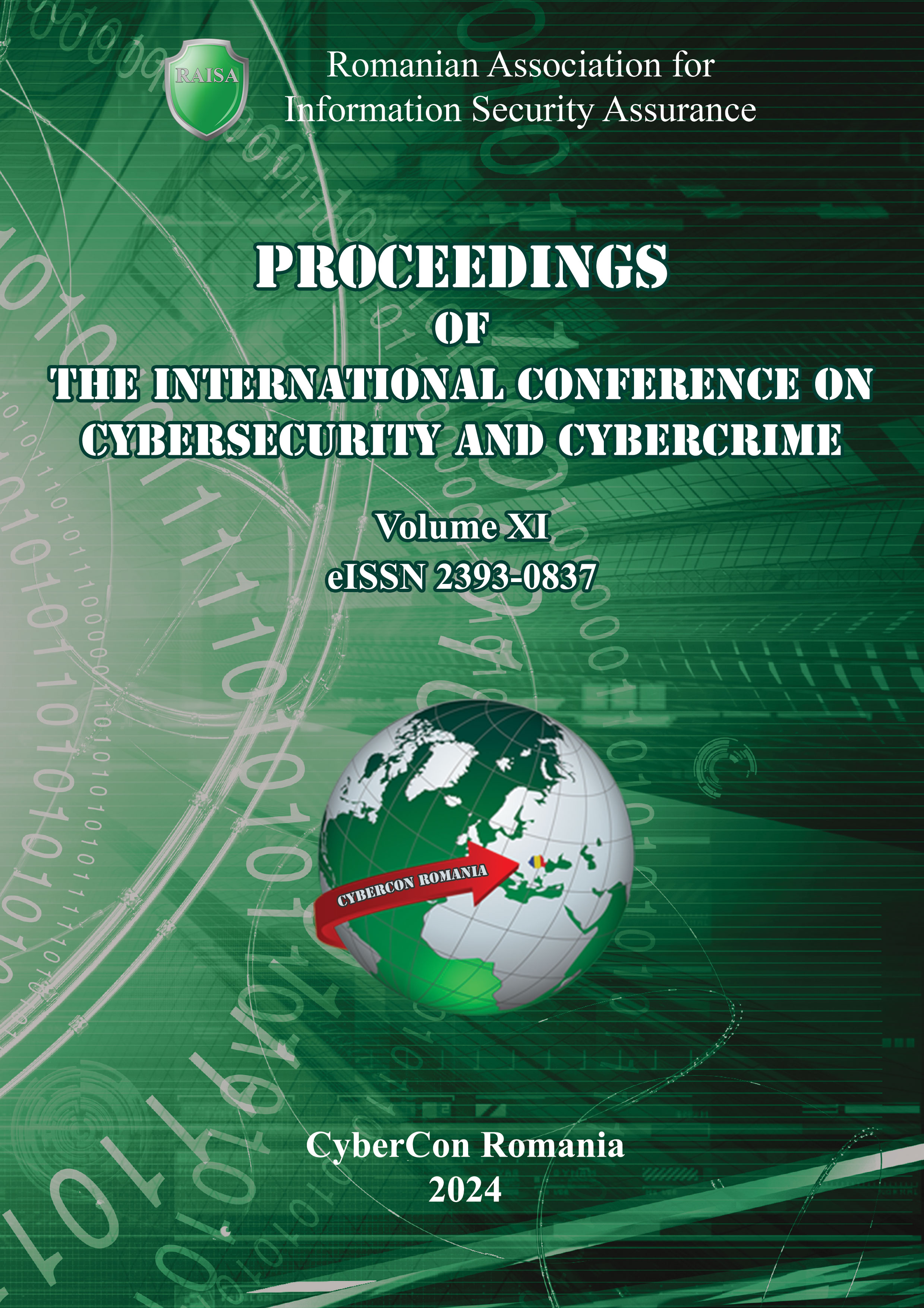
Keywords: Quality; Quality history; Quality evolution; Walter Shewhart; Cybersecurity; Future of Quality
Quality, an omnipresent characteristic, with a profound impact on the entire economic and social life, recently celebrated this year a century since it was founded as a science. In the first part of the paper, the author analyzes how quality was founded as a science and analyzes the contributions of Walter Shewhart, considered as the "father of modern quality", as well as other quality gurus in this direction. The author concludes that quality is a dynamic concept, which constantly evolved in the 100 years of its existence. The evolution of quality in this first century of existence is analyzed and the prospects for the development of this important field are highlighted. Some of the Romanian Association for Information Security Assurance (RAISA)'s contributions to the implementation of cybersecurity (an important component of quality) culture are highlighted. Finally, some workshops organized under the auspices of RAISA in May 2024 in order to celebrate a century of modern quality are briefly analyzed.
More...
Keywords: cybercrime; electronic payments; financial education; fraud prevention; payment fraud
The paper examines what effect the KiberPajzs initiative has on fraud detected in electronic payments in Hungary for the 2023-2024 period. First the current electronic payment fraud landscape of Hungary is described through cybercrime tendencies, the impact of digitalization on banking, and the regulatory background of electronic payments. Then the KiberPajzs initiative is introduced together with its related communicational, regulatory and law enforcement projects. Finally, the recent quarterly payment fraud data published by the Central Bank of Hungary is examined and the effects of KiberPajzs are evaluated. The author argues that the decrease in the number and value of fraudulent electronic transactions and the increase in identified failed fraud attempts coincide with the activities of the KiberPajzs initiative.
More...
Keywords: cybersecurity civilian-defence integration; E.U. cybersecurity framework; cyber threats; national security; E.U. sovereignty in cyberspace
The integration of civilian and defence sectors within the European Union's cybersecurity framework has become a strategic priority, driven by the increasingly complex nature of digital threats to both national and collective security. This paper examines the need for a systematic approach to enhance civilian-defence cybersecurity synergy, emphasising the importance of coordinated efforts to address a range of challenges, including ransomware, state-sponsored attacks, and hybrid warfare. The study highlights the strategic importance of this integration for national and E.U.-wide interests, identifying key obstacles such as fragmented policy frameworks, operational cultural differences, and resource allocation disparities. To bridge these gaps, the paper proposes strategic solutions, including regulatory harmonisation, joint training programmes, and investment in dual-use technologies. The research underscores the critical role of a unified policy approach in facilitating efficient resource allocation, streamlined communication, and faster incident response. Additionally, it explores the potential of emerging technologies, such as AI and quantum computing, to strengthen cybersecurity capabilities across sectors. Ultimately, the integration of civilian and defence efforts within the E.U.'s cybersecurity ecosystem is essential for building a resilient, cohesive, and adaptive framework, ensuring the protection of digital infrastructure, enhancing national security, and reinforcing the E.U.'s global leadership in cybersecurity.
More...
Keywords: Cybersecurity; GPS spoofing; Intrusion detection; NIS2 Directive; Unmanned Aerial Vehicles (UAVs)
Unmanned Aerial Vehicles (UAVs) have become essential tools in both military and civilian applications, from surveillance to infrastructure monitoring. However, their increased use has raised significant cybersecurity concerns, particularly regarding vulnerabilities to cyberattacks such as GPS spoofing, signal jamming, and data link interception. This paper reviews the key cybersecurity challenges facing UAVs and explores mitigation strategies to enhance UAV security, with a focus on potential applications in Albania. Drawing on recent studies, we examine common attack vectors, including man-in-the-middle (MITM) attacks, denial-of-service (DoS) attacks, and unauthorized data interception. These vulnerabilities pose risks not only to the safe operation of UAVs but also to the integrity of the critical infrastructure they monitor. To address these issues, the paper proposes robust encryption protocols, real-time monitoring systems, and the integration of machine learning-based intrusion detection techniques to safeguard UAV communications and operations. Furthermore, this research highlights the importance of aligning UAV security measures with the EU’s NIS2 Directive, offering recommendations on regulatory frameworks tailored to the Albanian context. The findings emphasize the need for a comprehensive approach to UAV cybersecurity, combining technological innovation with stringent regulatory oversight to ensure safe and secure UAV deployment in Albania's rapidly evolving digital landscape.
More...
Keywords: AR-in-a-Box; cybersecurity awareness; cybersecurity education; program evaluation; performance metrics
AR-in-a-Box, developed by the European Union Agency for Cybersecurity (ENISA), offers a comprehensive framework to guide organisations in creating effective cybersecurity awareness programs. Through a structured 8-step process, this toolkit helps organisations set objectives, secure resources, manage human capital, segment audiences, select communication tools, plan timelines, implement programs, and evaluate outcomes. This paper explores each step in detail, incorporating state-of-the-art research and real-world case studies to demonstrate AR-in-a-Box's effectiveness in fostering a cybersecurity-conscious culture. Through targeted communication, interactive elements, and performance metrics, AR-in-a-Box enables organisations to embed cybersecurity awareness and improve resilience against evolving cyber threats.
More...
Keywords: audio; automation; security; spectrum; tampering
In an age where most of the data we interact with daily is stored digitally, methods of checking its authenticity become more and more essential. This is especially true for sound, as the increasing public availability of AI models makes tampering with audio files easier than ever. In this paper, we will be investigating the current landscape of audio forensics as well as our new hardware-based solution for double encoding detection.
More...
Keywords: disinformation; deep fake; fake news; information war; psychological warfare
The terms "fake news" and "falsehood" have become ubiquitous in contemporary society. They influence or alter the way in which people perceive reality. The challenge of combating fake news lies in its ability to evade detection and capture the attention of a growing number of individuals. It has the potential to alter the way reality is perceived, impact the reputation of institutions and organisations, and even pose a threat to national security by influencing perceptions of values and risks. In today's context, fake news has emerged as a significant vulnerability, with the potential to be exploited as part of hybrid warfare strategies. One proposed method for combating the spread of fake news is the development of critical thinking skills that are specifically designed to identify such information and mitigate its influence on personal beliefs and values.
More...
Keywords: risk & vulnerability management; threat landscape; cyber threat intelligence; defence strategies; incident response; intrusion detection; frameworks and methodologies
The landscape of cyber threats is multifaceted, encompassing a wide array of attack vectors, including distributed denial of service (DDoS) attacks, phishing, man-in-the-middle attacks, password-based intrusions, remote exploitation, privilege escalation, and malware deployment. As the sophistication of cyber threats continues to advance, coupled with the development of increasingly sophisticated evasion techniques, traditional security mechanisms - such as firewalls, intrusion detection systems, antivirus software, and access control lists - are proving less effective in identifying and mitigating these complex threats. This underscores the urgent need for the development and implementation of innovative, more robust solutions to counteract the growing prevalence of cyber-attacks. The objective of this proposal is to examine the ENISA Cybersecurity Threat Landscape Methodology and explore potential advancements that integrate traditional decision-making frameworks with emerging cybersecurity technologies. As concerns over cyber warfare continue to escalate, nations must adopt adaptable cyber frameworks and methodologies capable of preventing cyber crises. Furthermore, these frameworks should foster greater international collaboration and participation in the ongoing global discourse on cybersecurity.
More...
Keywords: Barcode; QR Code; Dynamic QR; Payment; Scanner; SM2; SM3
Black and white barcodes have been employed recently to encode additional data inside of a designated area. A barcode is composed of gaps and bars that are ordered according to preset rules. However, as the demand for additional data storage increases, a new technology known as QR codes has been developed. However, security remains a major worry, so this is by no means the end. Mobile payment is necessary for mobile business. An easy-to-use mobile payment solution is needed to allow mobile users to execute transactions using their mobile devices in a reliable and safe manner. The purpose of this study is to give us dynamic QR code refreshes during financial payment. The paper's primary goal is to create and comprehend QR code technology in the context of today's global security environment.
More...
Keywords: Artificial Intelligence; opportunities; Public Order and National Safety; technology; vulnerabilities
Artificial Intelligence is an innovation of modern technology, a concept transformed into reality. It is the result of sustained work by talented computer science pioneers who have turned their dreams into reality. As we have shown in this article, Artificial Intelligence brings both opportunities and significant risks, given the access some people have to data and information that can influence our entire existence. Human specificity lies in the desire to overcome one's limits and to make one's everyday life easier. However, in a society in constant transformation, we must be aware that not everything that helps us is necessarily beneficial, and vice versa. The future will be the one that will judge the direction of the technology of modern society and our ability to adapt to new challenges. This revolutionary field represents an opportunity, but also a vulnerability, which prompts us to reflect and analyze: "How long will we use artificial intelligence before it starts using us?"
More...
Keywords: cyber security; cyber threats; intrusion; Threat Intelligence; security incidents; vulnerability management
Cyber threat intelligence technology becomes a necessity in the context of the exponential evolution of information systems. The methods used by malicious actors are constantly evolving, becoming more and more sophisticated over time, thus making the task of security teams more difficult. This article aims to investigate cyber threats, providing information necessary to understand and detect the mode of operation of the attack, to then decline and disseminate it within the information systems to be protected. Advanced threat intelligence thus supports proactive monitoring of emerging threats by determining trends in the cyber landscape.
More...
Keywords: cybercrime; phishing; website; cyber-attack; financial crime
This article examines the profile of individuals involved in cybercrime activities, focusing on their psychological traits, motivations and technical skills. The study identifies common typologies of cybercriminals, ranging from individual hackers to organized groups, and examines the factors that contribute to choosing this type of illegal activity, such as social influences and opportunities in the online environment. The research hypothesis argues that individuals who commit cybercrime exhibit distinct characteristics that vary according to their goals and resources. The research method used combines case analysis with interviews and comparative studies, highlighting the diversity of profiles and the adaptability of offenders to emerging technologies. The results provide useful insights for implementing preventive measures and streamlining cybercrime investigations.
More...